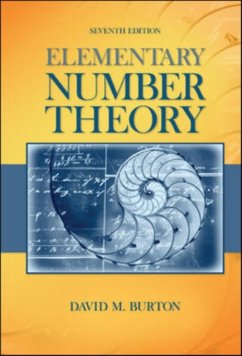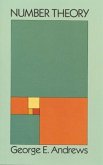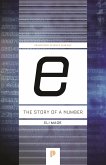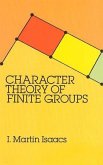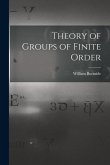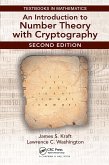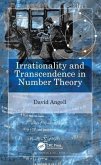David M. Burton
Elementary Number Theory
David M. Burton
Elementary Number Theory
- Gebundenes Buch
- Merkliste
- Auf die Merkliste
- Bewerten Bewerten
- Teilen
- Produkt teilen
- Produkterinnerung
- Produkterinnerung
Suitable for the one-semester undergraduate number theory course taken by math majors, secondary education majors, and computer science students, this text provides a simple account of classical number theory, set against a historical background that shows the subject's evolution since antiquity.
Andere Kunden interessierten sich auch für
![Number Theory Number Theory]() George E. AndrewsNumber Theory21,99 €
George E. AndrewsNumber Theory21,99 €![E: The Story of a Number E: The Story of a Number]() Eli MaorE: The Story of a Number14,99 €
Eli MaorE: The Story of a Number14,99 €![Character Theory of Finite Groups Character Theory of Finite Groups]() I. Martin IsaacsCharacter Theory of Finite Groups16,99 €
I. Martin IsaacsCharacter Theory of Finite Groups16,99 €![Theory of Groups of Finite Order Theory of Groups of Finite Order]() William BurnsideTheory of Groups of Finite Order26,99 €
William BurnsideTheory of Groups of Finite Order26,99 €![An Introduction to Number Theory with Cryptography An Introduction to Number Theory with Cryptography]() James KraftAn Introduction to Number Theory with Cryptography48,99 €
James KraftAn Introduction to Number Theory with Cryptography48,99 €![Irrationality and Transcendence in Number Theory Irrationality and Transcendence in Number Theory]() David AngellIrrationality and Transcendence in Number Theory52,99 €
David AngellIrrationality and Transcendence in Number Theory52,99 €![Algebraic Number Theory and Fermat's Last Theorem Algebraic Number Theory and Fermat's Last Theorem]() Ian StewartAlgebraic Number Theory and Fermat's Last Theorem71,99 €
Ian StewartAlgebraic Number Theory and Fermat's Last Theorem71,99 €-
-
-
Suitable for the one-semester undergraduate number theory course taken by math majors, secondary education majors, and computer science students, this text provides a simple account of classical number theory, set against a historical background that shows the subject's evolution since antiquity.
Hinweis: Dieser Artikel kann nur an eine deutsche Lieferadresse ausgeliefert werden.
Hinweis: Dieser Artikel kann nur an eine deutsche Lieferadresse ausgeliefert werden.
Produktdetails
- Produktdetails
- Verlag: McGraw-Hill Education - Europe
- 7 ed
- Seitenzahl: 448
- Erscheinungstermin: 4. Februar 2010
- Englisch
- Abmessung: 231mm x 160mm x 23mm
- Gewicht: 734g
- ISBN-13: 9780073383149
- ISBN-10: 0073383147
- Artikelnr.: 31792428
- Herstellerkennzeichnung
- Libri GmbH
- Europaallee 1
- 36244 Bad Hersfeld
- gpsr@libri.de
- Verlag: McGraw-Hill Education - Europe
- 7 ed
- Seitenzahl: 448
- Erscheinungstermin: 4. Februar 2010
- Englisch
- Abmessung: 231mm x 160mm x 23mm
- Gewicht: 734g
- ISBN-13: 9780073383149
- ISBN-10: 0073383147
- Artikelnr.: 31792428
- Herstellerkennzeichnung
- Libri GmbH
- Europaallee 1
- 36244 Bad Hersfeld
- gpsr@libri.de
Elementary Number Theory, 7e, by David M. Burton
Table of Contents
Preface New to this Edition 1Preliminaries
1.1Mathematical Induction
1.2The Binomial Theorem
2Divisibility Theory in the Integers
2.1Early Number Theory
2.2The Division Algorithm
2.3The Greatest Common Divisor
2.4The Euclidean Algorithm
2.5The Diophantine Equation
3Primes and Their Distribution
3.1The Fundamental Theorem of Arithmetic
3.2The Sieve of Eratosthenes
3.3The Goldbach Conjecture
4The Theory of Congruences
4.1Carl Friedrich Gauss
4.2Basic Properties of Congruence
4.3Binary and Decimal Representations of Integers
4.4Linear Congruences and the Chinese Remainder Theorem
5Fermat's Theorem
5.1Pierre de Fermat
5.2Fermat's Little Theorem and Pseudoprimes
5.3Wilson's Theorem
5.4The Fermat-Kraitchik Factorization Method
6Number-Theoretic Functions
6.1The Sum and Number of Divisors
6.2 The Möbius Inversion Formula
6.3The Greatest Integer Function
6.4An Application to the Calendar
7Euler's Generalization of Fermat's Theorem
7.1Leonhard Euler
7.2Euler's Phi-Function
7.3Euler's Theorem
7.4Some Properties of the Phi-Function
8Primitive Roots and Indices
8.1The Order of an Integer Modulo n
8.2Primitive Roots for Primes
8.3Composite Numbers Having Primitive Roots
8.4The Theory of Indices
9The Quadratic Reciprocity Law
9.1Euler's Criterion
9.2The Legendre Symbol and Its Properties
9.3Quadratic Reciprocity
9.4Quadratic Congruences with Composite Moduli
10Introduction to Cryptography
10.1From Caesar Cipher to Public Key Cryptography
10.2The Knapsack Cryptosystem
10.3An Application of Primitive Roots to Cryptography
11Numbers of Special Form
11.1Marin Mersenne
11.2Perfect Numbers
11.3Mersenne Primes and Amicable Numbers
11.4Fermat Numbers
12Certain Nonlinear Diophantine Equations
12.1The Equation
12.2Fermat's Last Theorem
13Representation of Integers as Sums of Squares
13.1Joseph Louis Lagrange
13.2Sums of Two Squares
13.3Sums of More Than Two Squares
14Fibonacci Numbers
14.1Fibonacci
14.2The Fibonacci Sequence
14.3Certain Identities Involving Fibonacci Numbers
15Continued Fractions
15.1Srinivasa Ramanujan
15.2Finite Continued Fractions
15.3Infinite Continued Fractions
15.4Farey Fractions
15.5Pell's Equation
16Some Recent Developments
16.1Hardy, Dickson, and Erdös
16.2Primality Testing and Factorization
16.3An Application to Factoring: Remote Coin Flipping
16.4The Prime Number Theorem and Zeta Function
Miscellaneous Problems Appendixes General References Suggested Further
Reading Tables Answers to Selected Problems Index
Table of Contents
Preface New to this Edition 1Preliminaries
1.1Mathematical Induction
1.2The Binomial Theorem
2Divisibility Theory in the Integers
2.1Early Number Theory
2.2The Division Algorithm
2.3The Greatest Common Divisor
2.4The Euclidean Algorithm
2.5The Diophantine Equation
3Primes and Their Distribution
3.1The Fundamental Theorem of Arithmetic
3.2The Sieve of Eratosthenes
3.3The Goldbach Conjecture
4The Theory of Congruences
4.1Carl Friedrich Gauss
4.2Basic Properties of Congruence
4.3Binary and Decimal Representations of Integers
4.4Linear Congruences and the Chinese Remainder Theorem
5Fermat's Theorem
5.1Pierre de Fermat
5.2Fermat's Little Theorem and Pseudoprimes
5.3Wilson's Theorem
5.4The Fermat-Kraitchik Factorization Method
6Number-Theoretic Functions
6.1The Sum and Number of Divisors
6.2 The Möbius Inversion Formula
6.3The Greatest Integer Function
6.4An Application to the Calendar
7Euler's Generalization of Fermat's Theorem
7.1Leonhard Euler
7.2Euler's Phi-Function
7.3Euler's Theorem
7.4Some Properties of the Phi-Function
8Primitive Roots and Indices
8.1The Order of an Integer Modulo n
8.2Primitive Roots for Primes
8.3Composite Numbers Having Primitive Roots
8.4The Theory of Indices
9The Quadratic Reciprocity Law
9.1Euler's Criterion
9.2The Legendre Symbol and Its Properties
9.3Quadratic Reciprocity
9.4Quadratic Congruences with Composite Moduli
10Introduction to Cryptography
10.1From Caesar Cipher to Public Key Cryptography
10.2The Knapsack Cryptosystem
10.3An Application of Primitive Roots to Cryptography
11Numbers of Special Form
11.1Marin Mersenne
11.2Perfect Numbers
11.3Mersenne Primes and Amicable Numbers
11.4Fermat Numbers
12Certain Nonlinear Diophantine Equations
12.1The Equation
12.2Fermat's Last Theorem
13Representation of Integers as Sums of Squares
13.1Joseph Louis Lagrange
13.2Sums of Two Squares
13.3Sums of More Than Two Squares
14Fibonacci Numbers
14.1Fibonacci
14.2The Fibonacci Sequence
14.3Certain Identities Involving Fibonacci Numbers
15Continued Fractions
15.1Srinivasa Ramanujan
15.2Finite Continued Fractions
15.3Infinite Continued Fractions
15.4Farey Fractions
15.5Pell's Equation
16Some Recent Developments
16.1Hardy, Dickson, and Erdös
16.2Primality Testing and Factorization
16.3An Application to Factoring: Remote Coin Flipping
16.4The Prime Number Theorem and Zeta Function
Miscellaneous Problems Appendixes General References Suggested Further
Reading Tables Answers to Selected Problems Index
Elementary Number Theory, 7e, by David M. Burton
Table of Contents
Preface New to this Edition 1Preliminaries
1.1Mathematical Induction
1.2The Binomial Theorem
2Divisibility Theory in the Integers
2.1Early Number Theory
2.2The Division Algorithm
2.3The Greatest Common Divisor
2.4The Euclidean Algorithm
2.5The Diophantine Equation
3Primes and Their Distribution
3.1The Fundamental Theorem of Arithmetic
3.2The Sieve of Eratosthenes
3.3The Goldbach Conjecture
4The Theory of Congruences
4.1Carl Friedrich Gauss
4.2Basic Properties of Congruence
4.3Binary and Decimal Representations of Integers
4.4Linear Congruences and the Chinese Remainder Theorem
5Fermat's Theorem
5.1Pierre de Fermat
5.2Fermat's Little Theorem and Pseudoprimes
5.3Wilson's Theorem
5.4The Fermat-Kraitchik Factorization Method
6Number-Theoretic Functions
6.1The Sum and Number of Divisors
6.2 The Möbius Inversion Formula
6.3The Greatest Integer Function
6.4An Application to the Calendar
7Euler's Generalization of Fermat's Theorem
7.1Leonhard Euler
7.2Euler's Phi-Function
7.3Euler's Theorem
7.4Some Properties of the Phi-Function
8Primitive Roots and Indices
8.1The Order of an Integer Modulo n
8.2Primitive Roots for Primes
8.3Composite Numbers Having Primitive Roots
8.4The Theory of Indices
9The Quadratic Reciprocity Law
9.1Euler's Criterion
9.2The Legendre Symbol and Its Properties
9.3Quadratic Reciprocity
9.4Quadratic Congruences with Composite Moduli
10Introduction to Cryptography
10.1From Caesar Cipher to Public Key Cryptography
10.2The Knapsack Cryptosystem
10.3An Application of Primitive Roots to Cryptography
11Numbers of Special Form
11.1Marin Mersenne
11.2Perfect Numbers
11.3Mersenne Primes and Amicable Numbers
11.4Fermat Numbers
12Certain Nonlinear Diophantine Equations
12.1The Equation
12.2Fermat's Last Theorem
13Representation of Integers as Sums of Squares
13.1Joseph Louis Lagrange
13.2Sums of Two Squares
13.3Sums of More Than Two Squares
14Fibonacci Numbers
14.1Fibonacci
14.2The Fibonacci Sequence
14.3Certain Identities Involving Fibonacci Numbers
15Continued Fractions
15.1Srinivasa Ramanujan
15.2Finite Continued Fractions
15.3Infinite Continued Fractions
15.4Farey Fractions
15.5Pell's Equation
16Some Recent Developments
16.1Hardy, Dickson, and Erdös
16.2Primality Testing and Factorization
16.3An Application to Factoring: Remote Coin Flipping
16.4The Prime Number Theorem and Zeta Function
Miscellaneous Problems Appendixes General References Suggested Further
Reading Tables Answers to Selected Problems Index
Table of Contents
Preface New to this Edition 1Preliminaries
1.1Mathematical Induction
1.2The Binomial Theorem
2Divisibility Theory in the Integers
2.1Early Number Theory
2.2The Division Algorithm
2.3The Greatest Common Divisor
2.4The Euclidean Algorithm
2.5The Diophantine Equation
3Primes and Their Distribution
3.1The Fundamental Theorem of Arithmetic
3.2The Sieve of Eratosthenes
3.3The Goldbach Conjecture
4The Theory of Congruences
4.1Carl Friedrich Gauss
4.2Basic Properties of Congruence
4.3Binary and Decimal Representations of Integers
4.4Linear Congruences and the Chinese Remainder Theorem
5Fermat's Theorem
5.1Pierre de Fermat
5.2Fermat's Little Theorem and Pseudoprimes
5.3Wilson's Theorem
5.4The Fermat-Kraitchik Factorization Method
6Number-Theoretic Functions
6.1The Sum and Number of Divisors
6.2 The Möbius Inversion Formula
6.3The Greatest Integer Function
6.4An Application to the Calendar
7Euler's Generalization of Fermat's Theorem
7.1Leonhard Euler
7.2Euler's Phi-Function
7.3Euler's Theorem
7.4Some Properties of the Phi-Function
8Primitive Roots and Indices
8.1The Order of an Integer Modulo n
8.2Primitive Roots for Primes
8.3Composite Numbers Having Primitive Roots
8.4The Theory of Indices
9The Quadratic Reciprocity Law
9.1Euler's Criterion
9.2The Legendre Symbol and Its Properties
9.3Quadratic Reciprocity
9.4Quadratic Congruences with Composite Moduli
10Introduction to Cryptography
10.1From Caesar Cipher to Public Key Cryptography
10.2The Knapsack Cryptosystem
10.3An Application of Primitive Roots to Cryptography
11Numbers of Special Form
11.1Marin Mersenne
11.2Perfect Numbers
11.3Mersenne Primes and Amicable Numbers
11.4Fermat Numbers
12Certain Nonlinear Diophantine Equations
12.1The Equation
12.2Fermat's Last Theorem
13Representation of Integers as Sums of Squares
13.1Joseph Louis Lagrange
13.2Sums of Two Squares
13.3Sums of More Than Two Squares
14Fibonacci Numbers
14.1Fibonacci
14.2The Fibonacci Sequence
14.3Certain Identities Involving Fibonacci Numbers
15Continued Fractions
15.1Srinivasa Ramanujan
15.2Finite Continued Fractions
15.3Infinite Continued Fractions
15.4Farey Fractions
15.5Pell's Equation
16Some Recent Developments
16.1Hardy, Dickson, and Erdös
16.2Primality Testing and Factorization
16.3An Application to Factoring: Remote Coin Flipping
16.4The Prime Number Theorem and Zeta Function
Miscellaneous Problems Appendixes General References Suggested Further
Reading Tables Answers to Selected Problems Index

